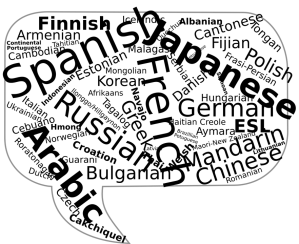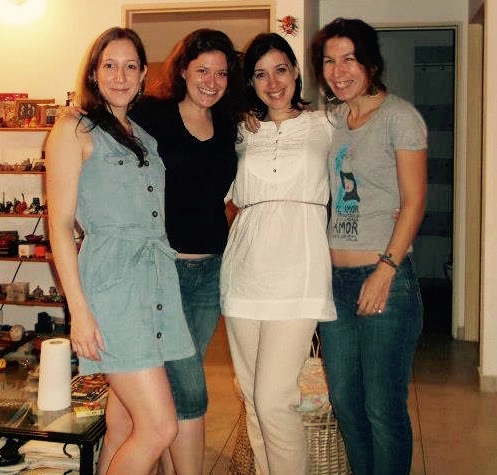 First of all, I want to explain the difference between being “bilingual” and “fluent”, in my opinion. “Fluency” is subjective and mainly refers to your ability to communicate well, even if you make mistakes or have a foreign accent. “Bilingual” means that you speak it as well as your native language. So, how long did it take me to get to the point where I speak Spanish as well as I speak English? Oh, about 20 years. Everyone is different, so I can only comment on my own process, but based on my own experience, here’s my formula for becoming bilingual:
First of all, I want to explain the difference between being “bilingual” and “fluent”, in my opinion. “Fluency” is subjective and mainly refers to your ability to communicate well, even if you make mistakes or have a foreign accent. “Bilingual” means that you speak it as well as your native language. So, how long did it take me to get to the point where I speak Spanish as well as I speak English? Oh, about 20 years. Everyone is different, so I can only comment on my own process, but based on my own experience, here’s my formula for becoming bilingual:
#1 STUDY THE GRAMMAR AND PRACTICE, PRACTICE, PRACTICE
The first thing I did was study Spanish. I took basic Spanish in high school, minored in Spanish in college, and did a semester abroad in Spain. I had to occasionally use Spanish at my job in Austin, Texas. When I lived in Prague I did a couple Spanish-English exchanges so I wouldn’t forget my Spanish while learning Czech. Later, when I moved to Buenos Aires, I went to conversation classes and a weekly grammar course. I also did numerous conversation exchanges or groups, went on dates, chatted up guys in bars, made local friends, and basically just jumped at any opportunity to practice with native speakers.

#2 BECOME A FAN OF THE CULTURE
When I was studying abroad in Spain I fell in love with Shakira’s “Dónde Están Los Ladrones” album, and translated all of the lyrics so that I could understand the songs. Over the years I became a fan of Julieta Venegas, Juanes, Belenova, Soda Stereo, Natalia Lafourcade and other music in Spanish, which I’m positive played an important role in my process. A friend of mine told me that becoming addicted to a “telenovela” helped him. I watched Almodóvar films with subtitles in Spanish (a great tip by the way). I went to salsa and tango classes. So, listen to music, watch TV, watch movies, read books, go see a play, take a class; basically, become a fan and consumer of the culture.

#3 GET A LONG-TERM LOCAL PARTNER
Having a long-term relationship in Spanish was my first major leap towards becoming bilingual. I was in that relationship for 5 years, so it wasn’t a quick process, but it forced me to learn how to communicate, and communicate well, on every subject matter under the sun.
Of course you can’t control who you fall in love with, but if possible, try to make that happen with someone that doesn’t speak your language (because as time goes by it will only get harder to switch the primary language of your relationship, even if you’re improving). I find that partners are often more patient than friends or other people when you’re still learning because a) they don’t really have a choice and b) you have other modes of communication that aren’t verbal to fall back on.

#4 GET A LOCAL JOB
After learning all of the grammar and several months into my relationship in Spanish, I started working in Spanish. Everyday I had to communicate in Spanish on the phone, in person and via email and chat. This was the next big leap in my progress. Just like a relationship forces you to communicate, and communicate well, so does a job. You have to understand the other person and make yourself understood, all while maintaining a certain level of professionalism. A special thanks to LV Studio, which is not only where I studied Spanish when I first arrived in Buenos Aires, but also the place that gave me a job.

#5 GO TO PUBLIC UNIVERSITY
After working in Spanish for about 6 months, I enrolled in a Master’s program at the University of Buenos Aires. I was able to understand most of what was being taught, and I got good grades, but it was seriously hard. Much like my relationship and my job were forcing me to accelerate my learning curve, attending public university forced me to up the ante even more by compelling me to speak like an educated person and participate in intellectual conversations. The social aspect of interacting with my classmates was also important.

#6 FORM GROUPS OF LOCAL FRIENDS
Communicating one-on-one is easier than participating in group conversations between native speakers, especially at a bar or restaurant. So, in my experience, integrating into local social groups is the last step. I pretty much had to already be bilingual to be successful at this. Why? Because to be an equal member of a group of friends you have to understand the conversation and participate equally. Without that, bonding is hindered. There was a steep slope to climb at the beginning, and I especially thank my classmates and friends from university for their patience during that time.

With my best friends from university
NOW REPEAT.

Wow, Emily! That’s true commitment. Good on you for making it happen. Great read! I enjoyed reading this post. ☺👍
LikeLike
thank you so much!
LikeLike
Ah which Telenovelas would you reccommend me watch? (I’m a teenager) whenever I google it theres too much to choose from haha
LikeLike
Thanks for your comment! I’m only familiar with Argentine shows, but definitely recommend them! My favorites are Graduados and Estocolmo, but for your age group I would suggest Casi Angeles or Chiquititas. Enjoy!
LikeLiked by 1 person
thank you!!
LikeLiked by 1 person